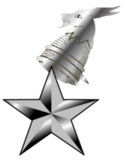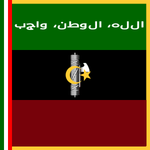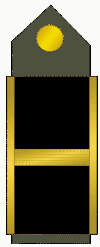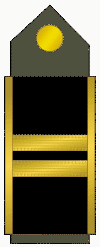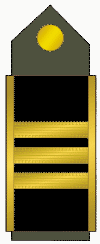Law enforcement in the Italian Empire
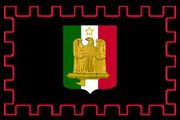
Law enforcement in the Autonomous Republics of the Italian Empire is carried out in order to ensure order and security in the Italian Empire; the whole of organs, bodies and agencies involved is used by the political authorities in order to achieve imperial goals of the Fascist State.
On general basis, all of bodies, organs and agencies have the goal to ensure the defence of the institutions and of the territory, to safeguard the physical and moral security, safety and health of populations of the Empire. The police bodies, in relation to this function, protect the integrity of the borders, ensure compliance with laws, regulations, orders of the authorities, maintain respect of religions and customs, protect labour and properties, maintain the security and safety of individuals, provide aid in the public and private accidents directing the work and the means, disengage all other particular tasks entrusted to them by relevant government authorities.
The law enforcement activity is usually carried out according organizational patterns quite different from the Italian model, although still retaining some similarities. The main difference consists of the fact that - with the Montenegrin exception - all police forces are Gendarmerie corps, without the civilian officials and with a reduced role for civilian governors. This is due to a variety of reasons: in Libya the public order conditions are so fragile and poor that the civilian management is unnecessary and generally unfit for a ready response which goes beyond the District boundaries, while in Ethiopia and Somalia the desert or uninhabited areas make unfit a civilian and city-based organization; in Eritrea the size of the operational area can be easily controlled from the central authority; finally, in Albania there is a well rooted Gendarmerie tradition and it is a recurring joke to say that Carabinieri managed to survive in a land that is almost Italy.
On the other hand, all autonomous republics have a Ministry of Interior and a Directorate-General of Public (Montenegro, Albania and Ethiopia) National (Libya) General (Somalia) Security (specific names could vary) organized like the Italian Directorate General; these "Autonomous" Directorates General are co-ordinated from Rome, although they do retain significant autonomy about local and non-political matters.
Contents
History
The current organization of law enforcement in the Italian Empire dates back to early 1960s, when the former Colonies were redesignated as "Special Government Regions", in order to disenfranchise them from the Italian direct rule. On one hand, the Italian Africa Police (Italian: Polizia dell'Africa Italiana) was deemed to be too much centralized and in contrast with the self-rule principle to be established; on the other hand, the Albanian Gendarmerie was already organized and well functioning. In 1964 a General Inspectorate was established in order to pursue the formation of Autonomous Republic-centred police services, which extensively draw from already existing units; this General Inspectorate was led by the then-Ministry of Colonies, and the Italian Public Security had almost no stake in it. In 1973 the Ministry of Colonies established the Division for Police Affairs and Cooperation, while a Commission for Common Security Interests was set up by Head of Government Amintore Fanfani in order to enable the Italian Police to participate. In 1986 the Ministry of Colonies was replaced by the Ministry of Imperial Affairs with the task of supporting the Italian Fascist imperial policy and of acting as the Empire executive arm for common affairs and the day-to-day running of the Empire; with the transformation, the Division for Police Affairs was merged with the Commission for Common Security Interests, forming the modern-day Directorate-General for Public Security.
Directorate-General for Public Security
The Directorate-General for Public Security (Italian: Direzione Generale per la Pubblica Sicurezza; Maltese: Direttorat Ġenerali għas-Sigurtà Pubblika; Corsican: Capu Diriggenti Generale di a Securità Public; Albanian: Drejtoria e Përgjithshme për Siguri Publike; Montenegrin: Generalna Direkcija za Javnu Sigurnost; Arabic: المديرية العامة للأمن العام al-mudiriat al-eammat lil'amn al-eamm; Ahmaric: የሕዝብ ደህንነት ለ ዳይሬክቶሬት ጄኔራል yeḥizibi dehinineti le dayirēkitorēti jēnērali) is a Directorate-General within the Ministry for Imperial Affairs, in charge for managing that aim at ensuring a stable, lawful and secure environment. The Directorate-General is aimed to coordinate fight to terrorism and organised crime, to oversee police cooperation and to prepare to swiftly respond to emerging crises. The Directorate has no executive powers per se, and its officials are not entitled to conduct investigations in the Imperial states or to directly arrest suspects, except in substitution (when the State is unable or unwilling) or with a specific authorization. The Directorate, in providing support through information exchange, intelligence analysis, expertise, and training, can contribute to the executive measures carried out by the relevant national authorities.
Three different levels of co-operation are in force:
- Training and technical co-operation;
- Strategic co-operation aimed at exchanging general trends in organised crime and how to fight it and the exchange of threat assessments;
- Exchange of personal data and requires the fulfilment of Europol's standards in the field of data protection and security
Organization
The Director-General of the Directorate is always the same official who is the Director-General of the Public Security of the Italian Interior Ministry; he is assisted by an Higher Council (formed by the chiefs of police of the Autonomous Republics) and by a Deputy Director (usually the chief of police of an Autonomous Republic). Officials leading divisions and sections are senior officers and officials of the various police forces and interior ministries. The Directorate-General is subdivided into three Divisions: General Affairs, Security, Migration. Each Division is in turn divided into Sections.
- Division I - Strategy and General Affairs; the Division is in charge for all general coordination tasks. It is subdivided into five Divisions:
- Inter-institutional Relations;
- Legal Affairs;
- International Coordination;
- Innovation;
- Research Centre;
- Division II - Security and Political Police; the division is in charge of all political police duties common to two or more States of the Italian Empire. It is subdivided into eight Offices:
- Police Cooperation and information exchange;
- Terrorism and radicalisation;
- Organised crime and Drugs Policy;
- Money laundering;
- Cybercrime;
- Public order and preventive surveillance
- Political police records;
- Communication and transport routes police;
- Division III - Internal and Authorized Migration;
- Document security;
- Borders and Security;
- Internal travels;
- Expulsion Policy;
- Common Border Management.
Inspectorates-General
There are three Inspectorates-General of Public Security in the Italian Empire: Balkans (Dodecanese, Montenegro and Albania); Libya and Malta; Italian East Africa (Ethiopia, Somalia, Eritrea). These Inspectorates-General are bodies tasked with ensuring actual cooperation between adjoining Republics.
The Inspectorates-General coordinate and oversee the performance of all the organs and services of the Body and the activities of its staff; study and propose to the Republics Heads provisions for harmonizing the actions of the police and their deployment and use. The Inspectors-General receive directives from the Minister of Imperial Affairs and the Director General of Public Security.
Albanian Gendarmerie
The Albanian Gendarmerie (Albanian: Xhandarmëria Shqiptare; Italian: Gendarmeria Albanese) is the Gendarmerie force of the Albanian Social Republic. Being an Albanian militarized police force, it has several entities which has to respond to: for police and security duties the Gendarmerie depends on the Albanian Ministry of Interior; for co-ordination purposes, it depends on the Directorate General of Public Security in Rome; finally, for military purposes it reports to the Army Higher Command Balkans head-quartered in Tirana. It is to be noted that the Albanian Gendarmerie is mainly a preventive force of public security, but it has also detective/repressive duties as a judicial police corps.
The Gendarmerie traces its origins back to 1915, when the Gendarmerie School was established by the Carabinieri. The Mission drafted, adapted from the Italian regulations, Regulations and General Staff as well as borrowed from the Italian model were the type of recruitment (voluntary and selective) and weaponry. During the late 1920s, the Royal Albanian Gendarmerie was re-organized and staffed by British officers as part of the Royal Albanian Army. In 1939, when Albania was annexed to Italy, it was merged with the Carabinieri, constituting the "Carabinieri Higher Command for Albania" (It.: "Comando Superiore Carabinieri per l'Albania"); after the proclamation of the Republic, the Higher Command was transformed in an autonomous Gendarmerie force. The first Commandant General of Albanian descent was Brigadier General Gajur Deralla, who held office from 1957 to 1960. The current Commandant General is Major General Gjon Ulbasoni, who took office in 2012.
The Gendarmerie has a General Command, held by a Major General, a General Staff, a Schools Command, 2 Legions (Gjirokastër and Tirana), 12 battalions (1 per Province), with 48 companies (1 per sub-prefecture) and 102 Territorial Stations. The Gendarmerie has 236 officers, 1,440 subofficers and 8,434 corporals and gendarmes. The Gendarmerie also has a Central Operational Unit (Al: Njësia Operative Qendrore; It: Unità Operativa Centrale) which handles most serious crimes, while for public order duties the Gendarmerie is often supported by the Fascist Militia. The Gendarmerie Schools Command is organized according to military patterns; the Gendarmerie Academy in Valona deals with officer training, while the two Cadet Gendarmes Schools, in Gjirokastër and Tirana, deal with troops training. The Subofficers training is carried out by the Gendarmerie Academy in Valona, which operates the Subofficers School. As for the Italian P.S. organization, Schools and Academy are strategically placed across the Country in order to provide and additional manpower reserve, in case of rebellions or uprisings.
Ranks and insignia
The Albanian Gendarmerie is led by a Major General, and therefore there is no Lieutenant General; when the Italian Lieutenant General conducts his inspections and visits, he wears his Italian uniform. From a graphic point of view, the officer insignia pattern is closely modelled on the Italian one, with the Generals' insignia coming from a reform proposal for all the Generals' insignia, also in Italian Corps. All officer rank insignia feature the Star as basic component. Subofficers are the Albanian translation of Italian Marshals, and they are military subofficers like the Italian counterpart: their insignia have the horizontal stripes of the non-Italian subofficers. Finally, enlisted ranks do not have sleeve insignia but shoulder boards depicting their rank; the Albanian Gendarmerie is the only Corps which has such a rank system. Enlisted ranks are six, just as the Italian CPR.
As a whole, the Albanian Gendarmerie is a State military corps, like the Republican Police Corps, and is part of the Italian military system, although its State is the Autonomous Republic of Albania, and not the Italian Social Republic. In order to display this different affiliation, the Albanian Gendarmerie has an its own version of the Military Star. The Albanian Military Star actually is an Italian Military Star surmounted by an Helm of Skanderberg, the Albanian most important national hero. This symbol has been inherited by the Italian Kingdom of Albania, and it is considered by Albanian nationalists a proud distinction.
Montenegrin Police
Law enforcement in Montenegro is primarily the responsibility of the Police Administration (Uprava Policije). This is a civilian law enforcement agency (the official status a civilian police force, with special statute, militarily organized) which constitutes the Directorate-General of Public Security (Generalni Direktorat za Javnu Bezbednost),in turn part of the Ministry of Interior Affairs. The police force, with 5,684 police officers, is legally controlled by the country's Law on Police, which make the police report also to the Italian Directorate-General of Public Security through the Directorate-General for Public Security of the Ministry of Imperial Affairs. The Police Administration consists of 6 departments and 4 other operational units, and the office of the Director-General of Public Security (Generalni Direktor za Javnu Bezbednost), who is the overall chief of the Police Administration.
The Departments within the Directorate are the General Authority Police Department, the Criminal Police Department, the Border Police Department, the Persons and Objects Protection Department, the Telecommunication and Electronics Department and the Planning, Development and Analysis Department. Operational units are: Forensic Operational Unit, Special Anti-Terrorist Unit, Special Police Unit, Operational Communications Centre.
For direct execution of law enforcement tasks on the territory of Montenegro, 8 Regional Police Units (Područne Jedinice Policije) exist, each with one or more Police Delegation (Delegacija Policije), as needed:
- Podgorica, Regional Police Unit (with Police Delegation in Danilovgrad, Cetinje and Kolašin)
- Nikšić Regional Police Unit (with Police Delegation in Plužine and Šavnik)
- Bar Regional Police Unit (with Police Delegation in Ulcinj)
- Herceg Novi Regional Police Unit (with Police Delegation in Kotor and Tivat)
- Berane Regional Police Unit (with Police Delegation in Rožaje, Plav and Andrijevica)
- Bijelo Polje Regional Police Unit (with Police Delegation in Mojkovac)
- Pljevlja Regional Police Unit (with Police Delegation in Žabljak)
- Budva Regional Police Unit
The Police Academy is located in Danilovgrad, and provides both basic police education, and professional and specialized training, as well as additional manpower as needed.
Rank insignia
The Montenegrin Police is led by a Brigadier General, and therefore there is no Lieutenant General; when the Italian Lieutenant General conducts his inspections and visits, he wears his Italian uniform. From a graphic point of view, the officer insignia pattern is closely modelled on the Yugoslav trend, with the five-point star instead of the eight-point star, with the stars numbers adapted to the Italian usage. All officer rank insignia feature the Star as basic component.
Libyan Gendarmerie
The Libyan Republican Gendarmerie (Arabic: الدرك الليبي الجمهورية الجماهير; al-Darak al-Jamhariyya al-‘Lybyia, Italian: Gendarmeria Repubblicana Libica) is the police force of Italian Libya. The public security activity is directed by the Chief of the Libyan Social Republic, who is also the Central Authority of Public Security. In this capacity, the Chief of the Republic exercises similar roles to those exercised by the Minister of Interior. On the other hand, Provincial Governors and Provincial Battalions Commanders, as well as the sanctioned tribal chiefs, are Local Authorities of Public Security. The sanctioned tribal chiefs are Authorities of Public Security only against those subjected to their tribal authority.
The Gendarmerie is commanded by a Major General who reports directly to the Chief of the Libyan Social Republic, as well as to the proper government and military structures; the Gendarmerie operates into a fragile environment, severely damaged by the 2011 revolt. In 2013 the Gendarmerie consists of 30,000 officers and troops. The current Commandant General is Major General Umar Abdullah el-Muhayshi, the third Commandant General of Libyan (African) descent, while Osama al-Juwaili is the Chief of Staff. Being a Libyan militarized police force, it has several entities which has to respond to: for local police and security duties the Gendarmerie depends on the Libyan Ministry of Interior and from the Directorate General of National Security; for co-ordination purposes, it depends on the Directorate General of Public Security in Rome; finally, for military purposes it reports to the Army Higher Command Libya head-quartered in Tripoli. It is to be noted that the Gendarmerie is mainly a preventive force of public security, but it has also detective/repressive duties as a judicial police corps. In public order services, the Gendarmerie is often assisted by the Libyan GNR, also due to the dangerous challenges it must face. Gendarmerie ranks follow closely those of the Italian Armed Forces, albeit translated. An officer candidate has to be a Libyan or Italian citizen at least twenty years of age, of good conduct and Fascist behaviour, in good physical condition, and not married to a foreigner.
The Libyan Gendarmerie traces its origins back to the Zaptié colonial gendarmerie raised by Italian governors. In Tripolitania and Cyrenaica the zaptié were generally used for patrolling rural areas in coastal regions, while mounted police operated in the southern desert regions. In 1953 the Zaptié were transformed into the then-Colonial Gendarmerie, with the former Carabinieri officers permanently assigned - upon their request - to the Colony in order to train and organize the new force. In 1963 the Libyan colony was disestablished and in its place the Mediterranean Special Government Region was created: this elevation coincided with the creation of the Libyan Gendarmerie; in 1971 new separate agencies to handle civil defence and fire protection were provided for by law, and in 1978 the first officer of African descent was appointed Chief of Staff, while the first Commandant General of African descent was Ahmed Abdelaziz al Mukthiri, who took office from 1989 to 1992. Nowadays , the Italian Libyan community still provide a steady flow of recruits, while internal nomadic tribes are under-represented.
The Gendarmerie is organized into a General Command (Commandant and General Staff), head-quartered in Tripoli and four Legions (Tunis, Tripoli, Benghazi and Sabha), which correspond to the four regions of Libya; the Sabha Legion, responsible for Fezzan surveillance, consists of few fixed units and highly mobile patrols, while the other three Legions are organized on Battalions (25, one per Province), 104 Companies and 312 territorial stations. The Officer training is conducted both in Tripoli and in Rome, specialist and technical training is performed in Tunis, while Subofficers and troops schools are established in Benghazi and in Sabha.
The Directorate General of National Security is the civilian governing body of the Libyan Gendarmerie; the Director General of the National Security is at the same time the Commandant General of the Gendarmerie, although the two offices are kept distinct. The Directorate General has four subordinate Divisions (Border and Immigration Control; Inspection and Audit; Legal Affairs; Public Relations) which deal with surveillance and strategic policies, while the Gendarmerie has, subordinate to the Commandant and to the General Staff, six central commands: Training, Criminal Intelligence, Traffic and Highway Security, Ports Security, Information Security and Operations.
While Tunis, Tripoli and Benghazi Legions are each directed by a Brigadier General, with a Colonel as Chief of Staff, District Battalions are ordinarily led by Lieutenant Colonels, although Benghazi, Tripoli and Tunis Battalions are led by full Colonels; each Battalion has 4 Companies (each commanded by a Captain), who are directly responsible for the whole District, with the Capital town treated in the same way of the countryside. The four additional Companies are employed for the major cities (Benghazi, Tripoli and Tunis) and for the General Head-quarters of both the Directorate and the Ministry. Territorial Stations of the Libyan Gendarmerie are detachments of the Companies, and have little formal autonomy, although de facto they have to manage all non-sensitive issues. Stations can be commanded by Lieutenants, or by Marshals.
Libyan training
The training of the Libyan Gendarmerie is operated by CPR officers, and it is designed in order to restore public faith into the police system, and to make Libyan Gendarmes trustworthy; this, in a social context where weapons are now widespread and the sectarian/ethnic/tribal revolt bordered civil war and still remains a threat. At their arrival at training camps, Libyan trainees are deprived of weapons, cameras, and recording devices, given a physical examination, and subjected to identification procedures. The P.S. training program consists of basic, intermediate, and advanced courses in both police and military skills; advanced levels of training are reserved for outstanding graduates who are groomed as instructors. The training includes a leadership package for officers and sub-officers on management-related subjects. The P.S. also provide training in specialized skills, such as VIP close protection, sharpshooting, and self-defence.
The objectives of the training are to develop the trainees’ physical and motivational skills, instruct trainees in technical subjects, develop a culture of safety in training and operations, and promote respect for law and moderate restraint in the use of force. Basic training is provided in three month-long courses separated by two one-week breaks. Trainees have to pass a final examination in physical conditioning and police and military skills. High performers are trained as instructors and as elite units. Poor performers are dismissed from the training. The most important aspect of the P.S. training is the extensive amount of time spent with trainees in discussing the role of police in a peaceful society and the moral and ethical responsibilities of a police officer in performing his duties. To introduce a spiritual element into the training and build relationships with trainees, the Italian training includes the Gendarme Prayer, that they say every day with the Libyan students both to demonstrate their own spirituality and to tap into the religious fervour of many of their students.
Ranks and insignia
The Libyan Gendarmerie is led by a Major General, and therefore there is no Lieutenant General; when the Italian Lieutenant General conducts his inspections and visits, he wears his Italian uniform. From a graphic point of view, the officer insignia pattern is closely modelled on the Arab trend (at least trend used by secularist and social republics), with the stars numbers adapted to the Italian usage. All officer rank insignia feature the Star as basic component.
Warrant Officers are the Libyan translation of Italian Marshals, and they are military sub-officers like the Italian counterpart: their insignia have the horizontal stripes of the non-Italian sub-officers. Finally, enlisted ranks have sleeve insignia. Enlisted ranks are six, just as the Italian CPR.
As a whole, the Libyan Gendarmerie is a State military corps, like the Republican Police Corps, and is part of the Italian military system, although its State is the Autonomous Republic of Libya, and not the Italian Social Republic strictu sensu.
Ethiopian Gendarmerie
The Ethiopian security is a complex matter due to the social, ethnic and religious complexity of the population of the Ethiopian Social Republic. The Ministry of Interior is in charge of handling security and policing affairs through the Directorate General of Public Security and through the Ethiopian Gendarmerie Corps (Ahmaric: ሐበሻ ፖሊስ, Häbäsha Polis, literally meaning "Ethiopian Police"; Italian: Corpo della Gendarmeria Etiope). Each of the 8 ethnically-based Provinces and the three Autonomous Cities consists of a Provincial Directorate for the Public Security and of a Provincial Gendarmerie Command (headed by a Major General). Provincial Gendarmerie Commanders in each of the 11 provinces work in conjunction with the Provincial Governors, but for the prevailing part Addis Ababa directs administration. The civilian Directorates of Public Security (both central and provincial) deal with administrative-political aspects of the police activities in support of the Ethiopian Government and of the Provincial Governors, while Gendarmerie commanders are the technical-operative authorities.
Both Interior officials and Gendarmes are part of all-Ethiopia services and, although enlisted Gendarmes after their conscription can be expected to serve in their native Province, this can never be assumed for granted, as both rewarding and punitive transfers are often ordered; officers cannot expect any fixed assignment. The all-Ethiopian nature is emphasized by the aggressive meritocracy in upper levels.
The Ethiopian Police University College is a public institution of higher education in Ethiopia dedicated to training Gendarmes officers and to offering higher eductation to other personnel. Its main campus is located in Sendafa, a town 38 kilometres north of Addis Ababa, while other facilities are placed in Dire Dawa.
The 160,000-strong Gendarmerie was established in 1971, by amalgamating the former Carabinieri forces deployed in Ethiopia, Askari units and bands, and the security services of the major cities. Since its establishment, the Gendarmerie has been sometimes an unreliable organization (especially in the first years, when the last loyalist Abyssinians were still serving) but it had never been an overtly rebellious corps. In the 1976 Soviet-backed revolt and coup attempt, the combat forces of the Gendarmerie actively supported the National Republican Guard in crushing down rebel nests in Addis Ababa and in Dire Dawa. Lieutenant General Tadesse Werede Tesfay is the current Commandant, the fourth of Ethiopian descent, while Italian Ethiopian officers are still a significant part of the officers corps.
Organization
The Ethiopian Gendarmerie Corps is organised on a territorial basis for law-enforcement missions. The territorial organization represents the core of the institution; it contains 80 percent of the force and is organized hierarchically in 11 Provincial Commands headed by Major Generals, 77 Zonal and 770 Woreda commands, headed by Colonels and Captains/Majors respectively. Outside the territorial organization, there are three special Divisions: the Mobile Division (mass maneuver and territorial support, based in Harare), the Specialist Units Division (specialist investigative skills, based in Bahir Dar) and the Central Investigative Division (organized crime and subversive activities, based in Awasa).
At its top, the Gendarmerie is headed by the Higher Command, consisting of the Commandant General (a Lieutenant General) and the Chief of Staff, all located in Addis Ababa. The Chief of Staff directs, coordinates and supervises all activities of the force. The Higher Command directly supervises the Directors of Administration, Health, Training, Engineering, the motor pool and the Veterinary Commission. On the Deputy Chiefs of Staff depend the Centre for Recruitment and Selection. Training Schools are established through the country, in order to provide an additional manpower reserve if strictly needed.
Ranks and insignia
The Ethiopian Gendarmerie is led by a Lieutenant General; when the Italian Lieutenant General conducts his inspections and visits, he wears his Italian uniform. From a graphic point of view, the officer insignia pattern are loosely inspired to the Italian trend, with the Italian Towered Crown replaced by an Ethiopian Imperial Crown. All officer rank insignia feature the triangular insignia as basic component.
As a whole, the Ethiopian Gendarmerie is a State military corps, like the Republican Police Corps, and is part of the Italian military system, although its State is Ethiopia, and not the Italian Social Republic strictu sensu.
Somali Gendarmerie
The Gendarmerie of Somalia (Somali: Gandarmaariiga ee Soomaaliya; Arabic: الدرك من الصومال, al Ddarak min al Ssumal; Italian: Gendarmeria della Somalia) is the national gendarmerie force and the law enforcement agency of the Autonomous Social Republic of Somalia. As with most other police forces in the world, its duties include crime fighting (including the enforcement of the Xeer), traffic control, maintaining public security, and counter-terrorism. It is under the jurisdiction of the Minister of Interior, Directorate-General of Public Security. The Gendarmerie serves as one of the principal organs of the Somali Government. While organised at a national level, each arm reports to a Regional police authority, which in turn divides its force by local Police Divisions, headquartered at local police stations. In an emergency, the Gendarmerie can be reached by dialing 888 from any telephone in Somalia.
The Gendarmerie of Somalia was established on 1 December 1960, following the dissolution of the Italian African Police; the newly established Gendarmerie corps inherited about 1,200 Somali policemen and 800 Italian policemen. Shortly afterwards, the Gendarmerie absorbed the Higher Command Carabinieri. After a transitional phase, Schools and other facilities were established by 1972. The first commander was former P.A.I. Colonel Graziano Funari, and all officers were Italian or Italian Somali. Starting from the mid-1970s, the corps pursued a moderate "somalization" policy in order to enable indigenous officers to take the command and the management, also because the ongoing debate in Italy wether the former colonies had to be disbanded or not. The first Somali commander was Colonel Jaamac Qoorsheel, who held command from 1976 to 1979. Nevertheless, Italian Somali presence remained significant through the years.
The organization of the Gendarmerie follows both the demographics of Somalia and the administrative divisions. Broadly speaking, the Gendarmerie has a Territorial Organization, a Mobile Organization (for riot control and armed services) and a Training Organization; some specialist units are directly attached to the General Command. The organization is closely modelled on the Carabinieri structure, with further adaptations in order to deal with scarce population density and arising security needs.
Ranks and Inisgnia
The Somali Gendarmerie is led by a Brigadier General; when the Italian Lieutenant General conducts his inspections and visits, he wears his Italian uniform. From a graphic point of view, the officer insignia pattern are loosely inspired to the Italian trend, with the Italian Towered Crown replaced by the Somalian seal. All officer rank insignia feature the Star insignia as basic component. As a whole, the Somali Gendarmerie is a State military corps, like the Republican Police Corps, and is part of the Italian military system, although its State is Somalia, and not the Italian Social Republic strictu sensu.

